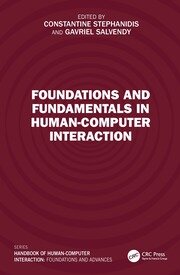Overview
“Foundations and Fundamentals in Human-Computer Interaction” by Constantine Stephanidis is a comprehensive textbook that provides a thorough introduction to the field of Human-Computer Interaction (HCI). It is designed for students, researchers, and professionals who are interested in understanding the principles and practices of designing effective and user-friendly computer interfaces.
### Key Features
1. **Introduction to HCI:**
– **Historical Context:** Explores the history and evolution of HCI, tracing its development from early computing to modern interactive systems.
– **Core Concepts:** Defines key terms and concepts in HCI, such as usability, user experience, and interaction design.
2. **Theoretical Foundations:**
– **Cognitive Psychology:** Discusses how human cognitive processes, such as perception, memory, and problem-solving, influence interaction with computer systems.
– **Design Principles:** Introduces fundamental design principles that guide the creation of intuitive and efficient user interfaces.
3. **User-Centered Design:**
– **User Research:** Covers methods for understanding user needs and behaviors, including interviews, surveys, and usability testing.
– **Prototyping and Evaluation:** Details techniques for creating and evaluating prototypes, ensuring that designs meet user requirements and expectations.
4. **Interaction Techniques:**
– **Input Devices:** Examines various input devices, from keyboards and mice to touchscreens and voice recognition systems.
– **Output Modalities:** Discusses different ways information can be presented to users, including visual, auditory, and haptic feedback.
5. **HCI Technologies:**
– **Emerging Technologies:** Explores the impact of new technologies on HCI, such as virtual reality, augmented reality, and wearable devices.
– **Adaptive Systems:** Looks at how systems can adapt to individual users and their contexts, enhancing the overall user experience.
6. **Applications of HCI:**
– **Domains:** Investigates HCI applications in various domains, such as healthcare, education, and entertainment.
– **Case Studies:** Provides real-world examples and case studies that illustrate successful HCI projects and their outcomes.
7. **Future Trends:**
– **Challenges and Opportunities:** Discusses future directions in HCI research and practice, including the challenges posed by emerging technologies and the opportunities for innovation.
### Learning Outcomes
By the end of the book, readers will:
– Understand the fundamental concepts and theories of HCI.
– Be able to apply user-centered design principles to create effective interfaces.
– Gain knowledge of various interaction techniques and technologies.
– Appreciate the wide range of applications for HCI.
– Be prepared to engage with current and future trends in the field.
### Audience
“Foundations and Fundamentals in Human-Computer Interaction” is suitable for:
– Students studying HCI, computer science, or related fields.
– Researchers seeking a comprehensive reference on HCI principles and practices.
– Professionals in the tech industry involved in designing and evaluating user interfaces.
– Anyone with an interest in the ways humans interact with computers and the impact of design on user experience.
Overall, Constantine Stephanidis’ “Foundations and Fundamentals in Human-Computer Interaction” serves as an essential resource for anyone looking to gain a solid grounding in the principles and practices of HCI. Its thorough coverage of both foundational and advanced topics makes it a valuable text for learning and reference.





